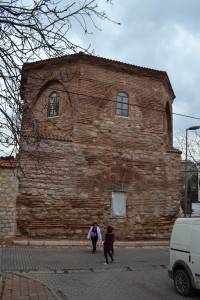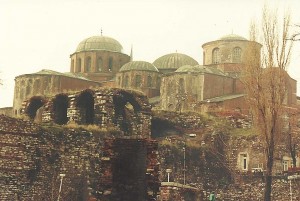In the 1990s, I often used to walk past this little brick octagon without realising that it was a Byzantine building. It is on the road down from At Pazarı in Fatih to the Zeyrek Camii (41.019089,28.955256). As of 2014, it is encased in a white shroud as Fatih Belediyesi does whatever it is going to do with it. It forms the wall of a neat little house attached to its northern side. Freely advances the idea that Şeyh Süleyman Mescidi was once a library or chapel of the monastery of the Pantokrator.
Active work had begun on restoration in August 2015.
It will be interesting to see the use to which Fatih Beledeyisi puts this lovely little building. The restoration appears to be nearing completion. I am hoping that it becomes a library. If so, it will be an Islamic one like the lovely Recai Mehmet Efendi Kütüphanesi in Vefa.
The roof is complete. August 2015

No such luck. The plan is for Şeyh Süleyman Mescidi to reopen as a mosque in mid-2016. The roof is finished and the shrouds are coming off. In January 2016, the caretaker said that the major building work was due to be completed by February/March. Interestingly, he is Syrian and has a better command of English than Turkish. An army of Belediye labourers is building a wall and a new road surface around the structure.
Şeyh Süleyman Mescidi opened as a mosque in February 2017.


Basın İlan Kurumu (2017) Restore edilen Şeyh Süleyman Mescidi açıldı. Available online at: http://www.bik.gov.tr/restore-edilen-seyh-suleyman-mescidi-acildi/ Accessed 25th Feb 2017

Posted June 28, 2014 Posted by Adam in Uncategorized
A great lumpy, looming thing, this bonding of two churches by an adhesive central chapel used to have a rugged charm in the 1990s. One could feel adventurous and daring, weaving through fences and ducking into tunnels, passages and cisterns. The bad-tempered Robert Liddell had a different experience in the 1950s, writing that Zeyrek Camii is now as nasty a place as you can find in a day’s walk in Constantinople. He complained that the whole place swarms with singularly nasty little boys, who seem to breed there, for the number increases at each subsequent visit. (Liddell p79) The descendants of these boys were there in 1990 but proved to be rather helpful in pointing out tunnels that led to somewhere interesting.
Now it’s having a makeover by Istanbul Buyuksehir Belediyesi. The supervising archaeologist is Sait Basaran, famous for his (and his daughter’s) work in Fatih Camii in Enez. The north church has reopened as a mosque. The decoration inside is a nice restrained monochrome. The outside has been done in that familiar way of making some alternating courses of brick and stone, then sandblasting it back to look a bit as though the poor building has been skinned. The south church has been stripped back to the arches and it is interesting to see its skeleton. The funeral chapel in the middle seems to be inaccessible.(41.019671,28.957418)
There is a good deal of academic disagreement over the ages of the various parts of the church, including the order of building. Some of the stained glass has ended up in the Archaeological Museum. It seems to indicate that this art originated in Constantinople, rather than further west.
There used to be an extensive monastery complex here. The massive cistern underneath is sometimes accessible and there are many remains of minor buildings in the area. One of these is the Şeyh Süleyman Mescidi.
There is a lot still to be found in this area. In a place where everyone has a Byzantine basement, conservation regulations will prevent major building works from bringing them to light. For the present, Zeyrek will remain as a little bit of the old Constantinople with pieces of Byzantium awaiting discovery.

Plot of land with substantial above-ground remains of buildings from the Monastery of the Pantocrator and many more underground.

Piri Mehmet Paşa Camii, built 1517 on the great cistern of the Pantocrator Monastery. Restored in 2013 with a lot of Byzantine components.

Next Entries »






























